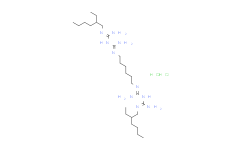| 英文别名 |
2,4,11,13-Tetraazatetradecanediimidamide,N1,N14-bis(2-ethylhexyl)-3,12-diimino-, hydrochloride (1:2);2,4,11,13-Tetraazatetradecanediimidamide,N1,N14-bis(2-ethylhexyl)-3,12-diimino-, hydrochloride...;Alexidine (hydrochloride);Alexidine dihydrochloride;Alexidine dihydrochloride,N,N\'\'-Bis(2-ethylhexyl)-3,12-diimino-2,4,11,13-tetraazatetradecanediimidamidedihydrochloride;Alexidine dihydrochloride,N,N''-Bis(2-ethylhexyl)-3,12-diimino-2,4,11,13-tetraazatetradecanediimidamidedihydrochloride;1,1'-Hexamethylene-bis(5-[2-ethylhexyl]biguanide);alexidine 2HCl;Bisguadine;Bisguanidine;Compound-904;QR-711;Sterwin 904;1,1′-Hexamethylene-bis(5-[2-ethylhexyl]biguanide);WIN-21904;1,1'-Hexamethylenebis[5-(2-ethylhex-1-yl)]biguanide dihydrochloride;N,N''-Bis(2-ethylhexyl)-3,12-diiMino-2,4,11,13-tetraazatetradecanediiMidaMide;N,N''-bis(2-ethylhexyl)-3,12-diimino-2,4,11,13-tetraazatetradecanediamidine dihydrochloride;N,N''-Bis(2-ethylhexyl)-3,12-diimino-2,4,11,13-tetraazatetradecanediimidamidedihydrochloride
|



 扫码关注公众号
扫码关注公众号